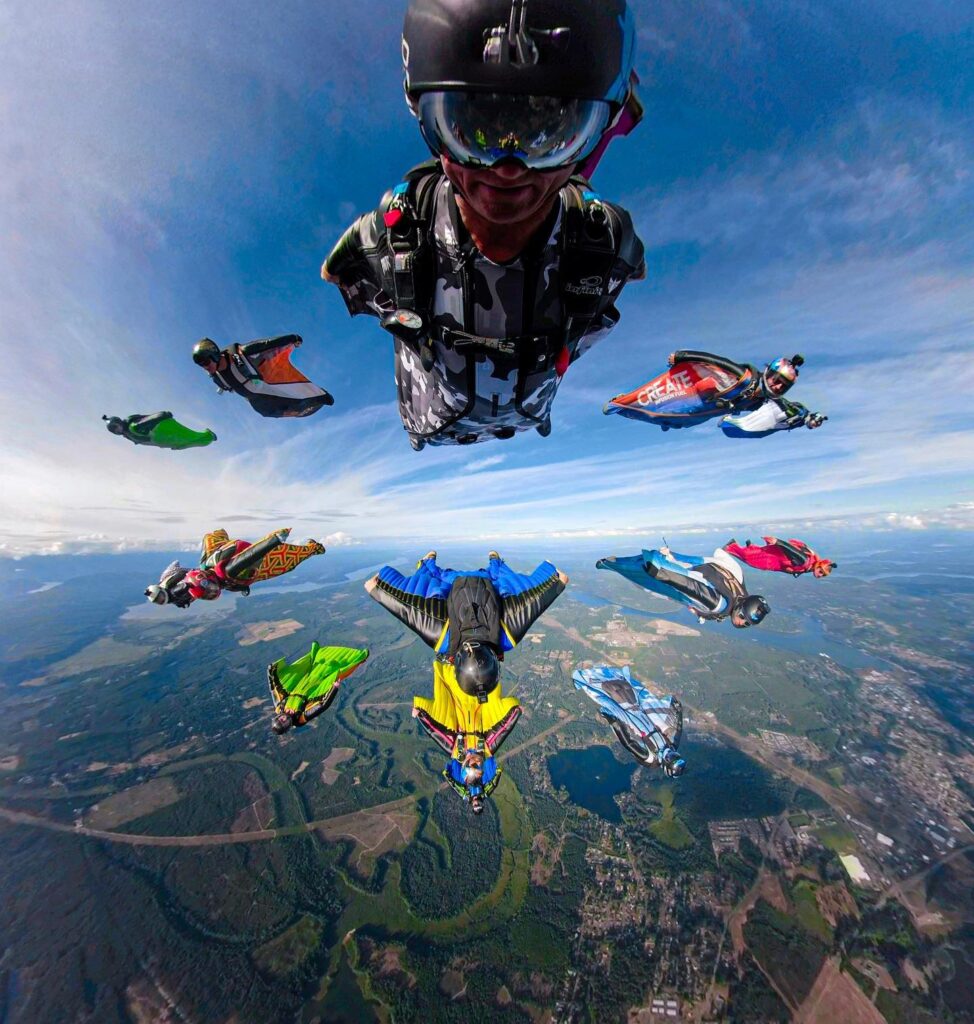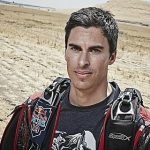Understanding suit models, and which is right for you, at what stage…

Wingsuits, to the untrained eye, all look pretty similar. They’ve got arm wings, a leg wing, and they inflate into a wing-shape.
Piece of cake.
To a slightly more informed jumper, the difference between a “big” suit and a “small” suit, are apparent – simply put, some wingsuits have bigger wings than others and most experienced skydivers will understand that the bigger the suit is, the more experienced the pilot should be to fly it. That “big / little” distinction is referred to as Surface Area, and while it’s definitely a lot more complicated than that, surface area explains a lot about wingsuit design and is the most obvious place to start.
Surface Area
Surface area is measured in square centimeters and varies primarily with suit model and pilot size. A beginner wingsuit will have low surface area, aka small wings. The reason for this is not that small wings are easier to control (in fact the opposite is true), but because small wings are easier to control when you are out of control. When you exit the aircraft on your first jump and begin to tumble, it’s much easier to regain control of a small-winged wingsuit, than a large-winged wingsuit.
Think of your wingsuit as an air mattress floating in the ocean. A large air mattress will be comfortable, stable, and easy to lay on. But if it starts to get pushed around, then it’s a lot of mattress to try and maintain control of. If a wave tries to flip it, good luck trying to wrest control of the mattress from the wave. A very small air mattress, in contrast, is less stable, harder to lay on comfortably, but if a wave pushes it around, you’ll have much more luck controlling it and hanging onto it. Wingsuits are the same. A big wingsuit is easier to lay on and fly in a straight line, but good luck regaining control of a large, advanced wingsuit on your first jump.

Photo : Amber Forte and Espen Fadnes, by Andreas Hemli
So, to bring this back to beginner suits, the reason they are small is because it is expected that a beginner will lose control of it and we want you to be able to regain control easily. Piloting that small surface area suit makes for excellent training, and once you’ve dialed in the control inputs needed to keep a small wingsuit stable on all axes (pitch, roll, yaw), then moving up to the next size will be easy, and enjoyable.
In the SQRL range, the smallest suit we offer is the Sprint. It’s ideal for your first few jumps – maybe just your first 1-2 jumps, and is the suit we recommend First Flight Course instructors to use in their schools. It’s not the suit we recommend that you buy… for that, we generally recommend the Swift. The Swift is slightly larger in surface area and offers a lot more performance and range, it’s perfect for your first year of flying and will allow you to fly with a lot of different beginner-intermediate wingsuits out there.
Suit Strengths
Apart from surface area, there is the type of flying that each wingsuit is designed for. Freestyle, Performance, and BASE, would be the three major categories that we identify. Inside each category there are multiple options depending on your skill, experience, and what your goals are within it.
A wingsuit with back inlets is clearly designed for back-flying. Hey, you don’t need back inlets for back-flying, but they sure do help a lot. Conversely, those back inlets add drag, so you won’t find them on a suit that is designed for performance flying.
A suit with a large amount of surface area is not going to be as agile as a suit with less – it will likely feel more powerful, but surface area is a fact of physics and more of it means more suit to wrestle. So, the biggest suit in the range is not going to be the best for freestyle flying.
Suit strengths line up into categories of surface area, speed range, and agility.

Photo: C-Race wingsuits pilots at the Red Bull Aces competition, Red Bull Content Pool
Difficulty
Like the tools from many other sports we enjoy, there is generally a trade-off between performance and ease of use. The biggest suits in our range will not be the easiest to control (even if they are the easiest to lay on, and fly in a straight line). But they will offer the most performance – the shortest starts in BASE jumping, the most glide performance in a competition, or the most power for freestyle flying. So generally speaking, bigger = more complicated and thus a higher skill level is required.
WS CATEGORIES
!! Disclosure Alert !!
I started a wingsuit company in 2012 and in this article I only refer to the suits my company makes. There are a lot of great options out there that you will find many opinions on. I’m only going to speak about what I know best, which is SQRL wingsuits.

First Flight Course
Easy choice, pick a Sprint if it’s available for your first couple of jumps. A Swift is also perfectly acceptable, particularly if you have a strong skydiving background (ie, more than the bare minimum 200 jumps).

Beginner
The Swift is the perfect first wingsuit. It serves most jumpers well for at least their first year of wingsuit skydiving. If you can put 75-100 jumps on one before moving up, do it! As wingsuits go, it’s the most “all-around” design that we know of. It has excellent performance, a great speed range (meaning that it flies fast, but also has a low stall speed), and is relatively easy to transition and back fly.

Intermediate
Now you’re at a crossroads. From the Swift, it’s acceptable to move up to a Freak, if you have at least 175 wingsuit jumps. If not, our first recommendation is the ATC series. The ATC is a fantastic second suit, and introduces the mid-chord surface area increase that all modern advanced wingsuits feature – this is the extra surface area on the arm wing that is concentrated around your hips, which extends in a straight line (parallel to chord) down to your ankles. It took many years of wingsuit design to arrive at this planform concept. It was first introduced by Tony Suits in 2008 with the release of their “Bird” series, which kick-started a new generation of higher performing wingsuits.
If you find yourself ready for the Intermediate class and you feel that your focus is really on freestyle flying, then take a look at the Vandal (not yet released as of Jan 2021) which was born in the tunnel and heavily influenced by the best acrobatic competitors of our time.

Photo by Puro Skydive
Advanced
Talk about choices. At this point, you could be heading in any direction, but we don’t know any advanced / expert wingsuit pilots who don’t want a Freak or similar suit in their arsenal. It’s sort of the obvious go-to suit for daily dropzone use. It’s fun, it’s fast, it’s agile, and it opens up a huge number of possibilities in freestyle flying and also in BASE. It is our primary Advanced – Freestyle design, and we think it’s without question the best all-around suit in this category.

Photo by Rachel Bakin
Advanced – BASE
Most of the suits in our advanced category are appropriate for advanced BASE use. The Freak series is a popular choice. The Colugo series is similar in surface area and difficulty, but is all about speed and glide, not freestyle flying.
For BASE jumpers who are looking for the best start & glide performance, the Corvid and Aura 4 are the suits to choose from.
Advanced – Performance
If you have your eye on performance competitions, then the C-Race and CR+ are the two suits to choose from. The difference is just surface area; the CR+ is essentially a C-Race with a bit more surface area to aid in time and distance tasks where the additional drag penalty from the additional surface is worth it because that additional surface area is also lift (potential).

What WS is Right for You?
This is a high-level, overview article for information and understanding. There is a lot more detail about each of our suits on our website… scroll down, there is tons of info. For personal advice, talk to your WS instructor or local expert, or contact us. Other manufacturers have similar pages with their recommendations.





